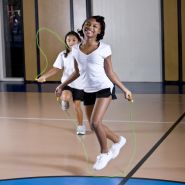Are your students getting enough exercise? Probably not, according to the latest research.
Government figures show that 79% of boys and 84% of girls don’t get the minimum of 1 hour of moderate exercise per day, as recommended by the UK chief medical officers.
Shocking as these figures are, they’re not that surprising when you consider that the average 11- to 15-year-old spends 7.5 hours every day looking at a screen, while children’s roaming range shrunk from 9.5km in 1915 to just 275m in 2015.
In 1971 80% of 7- and 8-year-olds walked to school; 20 years later this had fallen to just 10%.
Obesity
One – frankly terrifying – result of this (as well as other lifestyle changes) is that almost a third of children in the UK aged between 2 and 15 are classified as either overweight or obese.
Obese children are likely to remain such into adulthood, with all the attendant health problems such as increased risk of disease, disability and premature death.
Worryingly, Type 2 diabetes, which had previously been considered an adult illness, has increased dramatically in children as young as 5.
Conversely, regular exercise is associated with a whole host of health benefits. These include fitness, muscle and bone strength, improved quality of sleep and maintenance of a healthy weight.
Government research has even shown that more active children who regularly take part in physical activity and organised sport can benefit from improved academic performance. Regular exercise can also improve mental health.
Encourage children to be more active
So how are we to get our kids moving? Luckily, it’s not all bad news, and PE teachers are ideally placed to start the revolution.
But PE lessons are just the beginning and alone won’t achieve that government recommendation – the real challenge is to increase students’ physical activity outside of school.
There are several simple things teachers can do. Physical activity includes all activity, such as walking or cycling to get from A to B, gardening, dancing, playing active games and so on. So long as each activity takes at least 10 minutes it counts towards that 60-minute goal.
Think about how many of your students are driven to school, now think how many of them really need to be. By encouraging kids to walk or cycle to school you’ll be helping them to stay healthy, as well as helping to cut pollution.
Other activities could involve helping out parents in the garden, or volunteering at a nature reserve if there’s one close by; there are plenty of opportunities with the RSPB, Wildlife Trusts and National Trust, to name just a few.
Encourage some healthy competition by getting students to arrange matches after school or at weekends. Even if you already have teams for inter-school competitions, these unofficial,extra-curricular matches can offer opportunities for those not picked for a school team to be more active and participate at a suitable level.
For shorter bursts of activity, stuck in the mud and tag are classic playground games that students could easily play during break times.
We’ll be covering all these topics in greater detail in forthcoming posts, but in the meantime why not share your ideas for encouraging students to be more active?
Rebecca has been a writer and editor for almost 20 years. She writes on a huge range of subjects, concentrating on sport, nature, mental health, and crafts.










